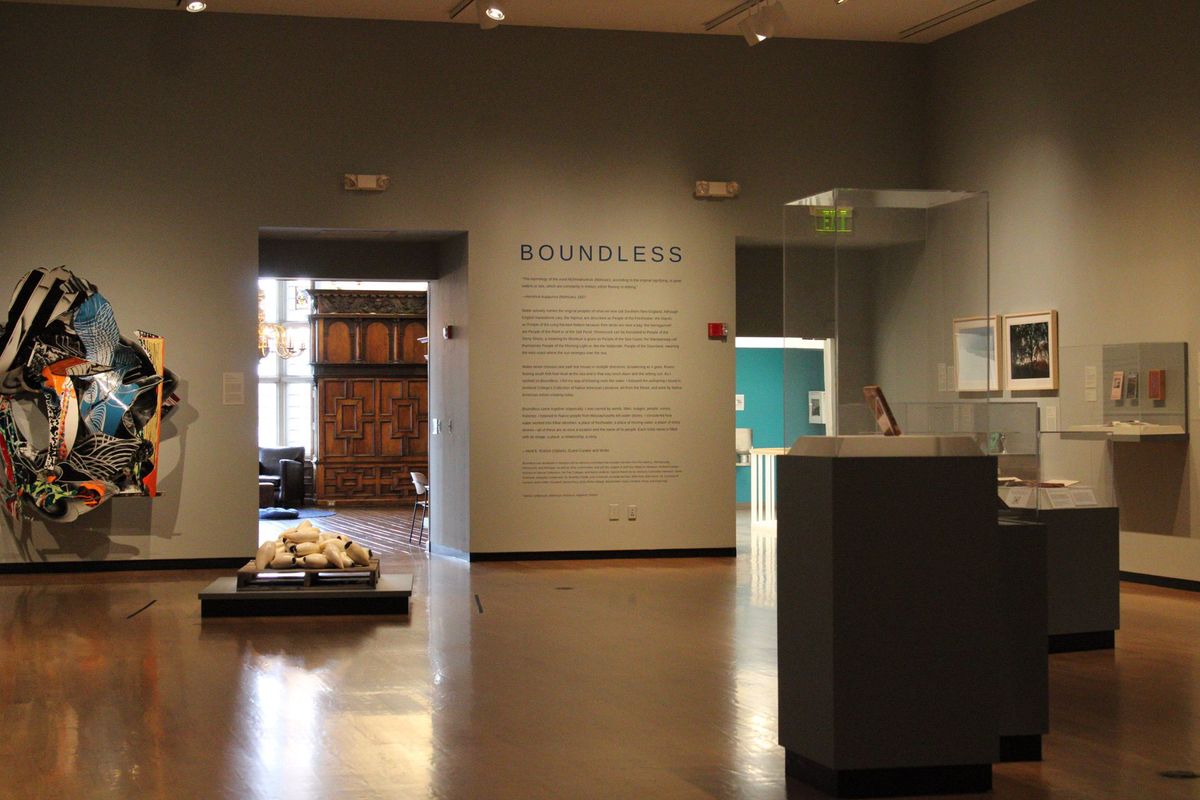“Boundless” Spotlights Native American Art
“Boundless,” a multimedia Native American art exhibition, is now on display at the Mead Art Museum. Staff Writer Tiia McKinney ’25 reports on her experience navigating the space, the gallery’s development, and the featured artworks.

When I think of something boundless, I think of something free — free from the confines of society or even the confines of time and other constructs that may seem natural. “Boundless,” a new exhibit featuring work by Native American artists and writers, hosted its opening reception Thursday, Sept. 14 at the Mead Art Museum. The exhibit is open through Jan. 7, 2024. Curator Heid E. Erdrich explained that she used water as her guide to select pieces for the exhibit. From the moment I heard the organizers speak, I realized how truly freeing this exhibit was. My experience was completed by the friends who joined me, the new food we tried, and the beautiful display of community as everyone shared their experiences and their journeys to Amherst.
“Boundless” challenged my perhaps narrow vision of what I expect to see in a gallery. Instead of simply paintings on canvas, the pieces used a wide array of materials, testing spatial concepts and working in three-dimensional platforms. The pieces made visitors consider the contingency of viewership on perspective and place. For example, I became entranced with a sculpture of folded aluminum planes. I spent minutes just staring at the angles of the piece moving from angle to angle, looking at the whales and the water and analyzing how each piece of aluminum moved into the other. I was also drawn to a crate on the ground that evoked an image of wooden crates floating in the ocean. On top of this wood, there were ceramic pieces in a yellowish color that reminded me of whales’ teeth.
While these pieces had vastly different mediums, they intrigued me in the same way. I began to imagine the ways the ocean connects with us throughout our struggles and daily life. I had the opportunity to speak to one of the artists, Jonathan James-Perry, whose work is “grounded in the traditions of his ocan-going ancestors.” He created two paddles for the exhibit made of white ash trees and explained that the chunks carved in the paddles represent the struggles that Native Americans have endured.

All of these pieces defied the confines of space and the Eurocentric ideas of what we consider to be art.
Moving towards the back of the museum, there were recipes pasted on the walls and scrolls for visitors to take home. While walking through this section of the exhibit, an artist named Hawk Henries, a member of the Chaubunagungamaug band of Nipmuck, played smooth notes with a Woodlands flute, which he explained were influenced by the time he spent picking plants with his family. I exited the museum listening to these nature-inspired songs, which helped me understand the art’s theme of connectivity, of resonances among ourselves and with nature. I also listened to a museum-provided audio tour that included more flute songs, poetry readings, and the calming sounds of the ocean flowing. Continuing through the museum, there were pieces on canvas of the Connecticut River, portraits, and even animals, showing the kinship among us all.
The pieces drew inspiration from modern artists as well as artists of past generations that were brought to light from the Amherst Archives. Among works that transgressed the boundaries of the present, I was reminded again of the boundless ocean that is so vast and yet intimate, moving through all of us.
The exhibit came together through the collaboration of many communities. I had the opportunity to talk to Erdrich, and she explained to me that the exhibit took three years to curate because she had to request permission from the artists and their communities. Erdich told me that the exhibit flows like a circle — a structure where nobody is centered and instead we all are equally incorporated.
“Boundless” was made possible by many people: Erdrich and the contributing artists, but also as Amherst students and local organizations. After three years of work, this exhibit is finally on display to showcase Native American art. I encourage everyone to take a tour around the Mead Museum to explore the multimedia art of “Boundless.”





Comments ()